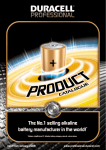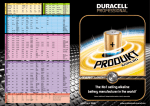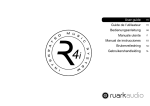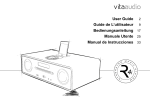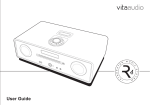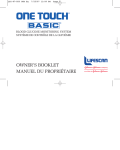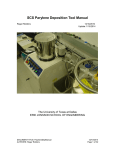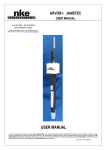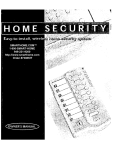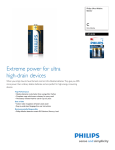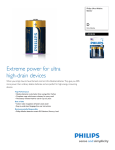Download Duracell 7k 67 User's Manual
Transcript
Material Safety Data Sheet SECTION 1: PRODUCT AND COMPANY IDENTIFICATION Product Name: DURACELL ALKALINE BATTERIES Product Identification: Alkaline Manganese Dioxide Cells – Duracell Designations: 7K67; MN1203; MN1300; MN1400; MN1500; MN2400; MN1604; MN908; MN918; MN9100; MX1604; MX2500; MX1300; MX1400; MX1500; MX2400 Product Use: Energy Source MSDS Date of Preparation: July 1, 2008 Company Identification US Office Duracell, a division of P&G Berkshire Corporate Park 14 Research Drive Bethel, CT USA 06401 (203) 796-4000 Canadian Office Duracell, a division of P&G 4711 Yonge Street Toronto, Ontario Canada M2N 6K8 (416) 730-4711 Emergency Phone Number: INFOTRAC Emergency Response Hotline 1-800-535-5053 (US & Canada) SECTION 2: HAZARDS IDENTIFICATION Physical Appearance: Copper top battery. EMERGENCY OVERVIEW CAUTION: May explode or leak, and cause burn injury, if recharged, disposed of in fire, mixed with a different battery type, inserted backwards or disassembled. Replace all used batteries at the same time. Do not carry batteries loose in your pocket or purse. Do not remove the battery label. Potential Health Effects: The chemicals and metals in this product are contained in a sealed can. Exposure to the contents will not occur unless the battery leaks, is exposed to high temperatures or is mechanically, physically, or electrically abused. Damaged battery will release concentrated potassium hydroxide, which is caustic. Anticipated potential leakage of potassium hydroxide is 2 to 20 mL, depending on battery size. Eye Contact: Contact with battery contents may cause severe irritation and burns. Eye damage is possible. Skin Contact: Contact with battery contents may cause severe irritation and burns. Inhalation: Inhalation of vapors or fumes released due to heat or a large number of leaking batteries may cause respiratory and eye irritation. Ingestion: Swallowing is not anticipated due to battery size. Choking may occur if smaller AAA batteries are swallowed. Ingestion of battery contents (from a leaking battery) may cause mouth, throat and intestinal burns and damage. GMEL # 2002.9 Page 1 of 6 SECTION 3: COMPOSITION/INFORMATION ON INGREDIENTS Chemical Name Manganese Dioxide Zinc Potassium Hydroxide (35%) Graphite (natural or synthetic) CAS Number 1313-13-9 7440-66-6 1310-58-3 7782-42-5, 7440-44-0 Amount 35-40% 10-25% 5-10% 1-5% SECTION 4: FIRST AID MEASURES Eye Contact: If battery is leaking and material contacts the eye, flush thoroughly with copious amounts of running water for 30 minutes. Seek immediate medical attention. Skin Contact: If battery is leaking and material contacts the skin, remove any contaminated clothing and flush exposed skin with copious amounts of running water for at least 15 minutes. If irritation, injury or pain persists, seek medical attention. Inhaled: If battery is leaking, contents may be irritating to respiratory passages. Move to fresh air. If irritation persists, seek medical attention. Swallowed: If battery contents are swallowed, do not induce vomiting. If the victim is alert, have them rinse their mouth are the surrounding skin with water for at least 15 minutes. Seek immediate medical attention. Note: This MSDS does not include or address the small button cell batteries which can be ingested. SECTION 5: FIRE FIGHTING MEASURES Fire and Explosion Hazards: Batteries may burst and release hazardous decomposition products when exposed to a fire situation. Extinguishing Media: Use any extinguishing media that is appropriate for the surrounding fire. Special Fire Fighting Procedures: Firefighters should wear positive pressure self-contained breathing apparatus and full protective clothing. Fight fire from a distance or protected area. Cool fire exposed batteries to prevent rupture. Use caution when handling fire-exposed containers (containers may rocket or explode in heat of fire). Hazardous Combustion Products: Thermal degradation may produce hazardous fumes of zinc and manganese; hydrogen gas, caustic vapors of potassium hydroxide and other toxic by-products. SECTION 6: ACCIDENTAL RELEASE MEASURES Notify safety personnel of large spills. Caustic potassium hydroxide may be released from leaking or ruptured batteries. Clean-up personnel should wear appropriate protective clothing to avoid eye and skin contact and inhalation of vapors or fumes. Increase ventilation. Carefully collect batteries and place in an appropriate container for disposal. GMEL # 2002.9 Page 2 of 6 SECTION 7: HANDLING AND STORAGE Avoid mechanical or electrical abuse. DO NOT short circuit or install incorrectly. Batteries may explode, pyrolize or vent if disassembled, crushed, recharged or exposed to high temperatures. Install batteries in accordance with equipment instructions. Do not mix battery systems, such as alkaline and zinc carbon, in the same equipment. Replace all batteries in equipment at the same time. Do not carry batteries loose in a pocket or bag. Do not remove battery tester or battery label. Storage: Store batteries in a dry place at normal room temperature. Do not refrigerate – this will not make them last longer. SECTION 8: EXPOSURE CONTROLS/PERSONAL PROTECTION The following occupational exposure limits are provided for informational purposes. No exposure to the battery components should occur during normal consumer use. Chemical Name Manganese Dioxide Zinc Potassium Hydroxide Graphite (natural-non-fibrous) Graphite (synthetic non-fibrous) Exposure Limits 5 mg/m3 Ceiling OSHA PEL 0.2 mg/m3 TWA ACGIH TLV None established for zinc metal 2 mg/m3 Ceiling ACGIH TLV 15 mppcf TWA OSHA PEL 2 mg/m3 TWA (respirable dust) ACGIH TLV 5 mg/m3 TWA (respirable dust), 15 mg/m3 TWA (total dust) OSHA PEL 2 mg/m3 TWA (respirable dust) ACGIH TLV Ventilation: No special ventilation is needed for normal use. Respiratory Protection: None required for normal use. Skin Protection: None required for normal use. Use neoprene, rubber or latex gloves when handling leaking batteries. Eye Protection: None required for normal use. Wear safety goggles when handling leaking batteries. SECTION 9: PHYSICAL AND CHEMICAL PROPERTIES Appearance and Odor: Copper top battery. Specific Gravity: Not applicable Water Solubility: Insoluble Vapor Pressure: Not applicable Vapor Density: Not applicable Boiling Point: Not applicable Melting Point: Not applicable Flash Point: Not applicable Autoignition Point: Not applicable SECTION 10: STABILITY AND REACTIVITY Stability: This product is stable. Incompatibility/Conditions to Avoid: Contents are incompatible with strong oxidizing agents. Do not heat, crush, disassemble, short circuit or recharge. GMEL # 2002.9 Page 3 of 6 Hazardous Decomposition Products: Thermal decomposition may produce hazardous fumes of zinc and manganese; caustic vapors of potassium hydroxide and other toxic by-products. Hazardous Polymerization: Will not occur SECTION 11: TOXICOLOGICAL INFORMATION Acute Toxicity Data: Manganese Dioxide: LD50 oral rat >3478 mg/kg Potassium Hydroxide: LD50 oral rat 273 mg/kg Chronic Effects: The chemicals in this product are contained in a sealed can and exposure does not occur during normal handling and use. No chronic effects would be expected from handling a leaking battery. Target Organs: Skin, eyes and respiratory system. Carcinogenicity: None of the components of this product are listed as carcinogens by ACGIH, IARC, NTP or OSHA. SECTION 12: ECOLOGICAL INFORMATION No ecotoxicity data is available. This product is not expected to present an environmental hazard. SECTION 13: DISPOSAL INFORMATION Disposal should be in accordance with Federal, state/provincial and local regulations. Products covered by this MSDS, in their original form, when disposed as waste, are considered non hazardous waste according to Federal RCRA regulations (40 CFR 261). Alkaline batteries can be safely disposed of with normal household waste. Due to concerns about mercury in the municipal solid waste stream, Duracell has voluntarily eliminated all of the added mercury from its alkaline batteries since 1993. Individual consumers may dispose of spent (used) batteries with household trash. Duracell does not recommend that spent batteries be accumulated and disposed of in large quantities. Do not incinerate except for disposal in a controlled incinerator. Some communities offer recycling or collection of alkaline batteries – contact your local government for disposal practices in your area. SECTION 14: TRANSPORT INFORMATION Products covered by this MSDS, in their original form, are considered “dry cell” batteries and are not regulated for transportation as “DANGEROUS GOODS.” The batteries must be packaged in a manner that prevents the generation of a dangerous quantity of heat and short circuits. For finished packaged product transported by ground (US DOT): – not regulated For finished packaged product transported by sea (IMDG) – not regulated For finished packaged product transported by air (IATA): – not regulated GMEL # 2002.9 Page 4 of 6 Special provisions apply and shippers should consult the most current versions of the transportation regulations. SECTION 15: REGULATORY INFORMATION United States OSHA Status: While the finished product(s) is considered an article and not covered by the OSHA Hazard Communication Standard, 29 CFR 1910.1200, this MSDS contains valuable information critical to the safe handling and proper use of the product". EPA TSCA Status: All intentionally-added components of this product are listed on the US TSCA Inventory. SARA 313/302/304/311/312 chemicals: Manganese compounds 35-40%, Zinc 10-25% California: This product has been evaluated and does not require warning labeling under California Proposition 65. State Right-to-Know and CERCLA: The following ingredients present in the finished product are listed on state right-to-know lists or state worker exposure lists Ingredient Manganese Dioxide Zinc Potassium Hydroxide Graphite CAS # 1313-13-9 7440-66-6 1310-58-3 7782-42-5 7440-44-0 Level 35-40% 10-25% 5-10% 1-5% CERCLA RQ None 1000 lb 1000 lb None IL Y Y Y Y MA Y Y Y Y State NJ N Y Y N PA Y Y Y Y RI Y N Y Y Canada All intentionally-added components of this product are listed on the Canadian DSL. This product has been classified in accordance with the hazard criteria of the Canadian Controlled Products Regulations (CPR) and this MSDS contains all information required by the Controlled Products Regulations. SECTION 16: OTHER INFORMATION P&G Hazard Rating: Health: 0 Fire: 0 Reactivity: 0 =========================================================================== Data supplied is for use only in connection with occupational safety and health. DISCLAIMER: This MSDS is intended to provide a brief summary of our knowledge and guidance regarding the use of this material. The information contained here has been compiled from sources considered by Procter & Gamble to be dependable and is accurate to the best of the Company’s knowledge. It is not meant to be an all-inclusive document on worldwide hazard communication regulations. This information is offered in good faith. Each user of this material needs to evaluate the conditions of use and design the appropriate protective mechanisms to prevent employee exposures, property damage GMEL # 2002.9 Page 5 of 6 or release to the environment. Procter & Gamble assumed no responsibility for injury to the recipient or third persons, or for any damage to any property resulting from misuse of the product. GMEL # 2002.9 Page 6 of 6






